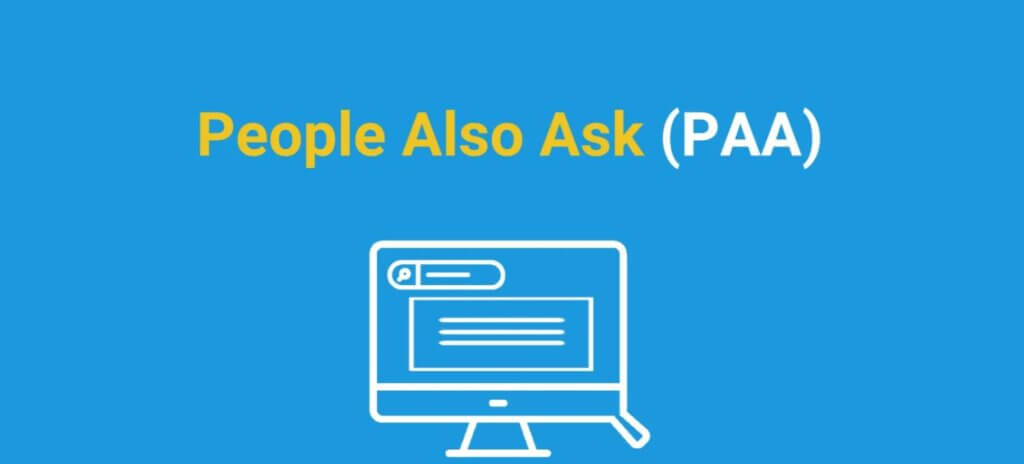People Also Ask (PAA)
Introduction to People Also Ask (PAA)
People Also Ask (PAA) is a feature appearing in popular search engine results in pages (SERPs) search engines like Google and Bing. PAA provides users a list of related questions and answers relevant to their initial search query. Google introduced this feature in 2015, and has since become an integral part of the search engine’s user interface.
Importance of People Also Ask (PAA)
PAA is important because it provides users with additional information related to their search query without requiring them to perform a new search. This helps to improve the user experience and saves users time. Additionally, PAA can increase click-through rates, as users may be more likely to click on one of the questions or answers provided in PAA. This can lead to increased traffic and visibility for websites that are featured in PAA.
Examples of People Also Ask (PAA)
An example of PAA in action can be seen when searching for a term like “How to make lasagna.” In the SERPs, there may be a section titled “People Also Ask,” which provides a list of related questions such as “How many layers should lasagna have?”, “Can you make lasagna without cheese?” and “What type of cheese is best for lasagna?”. Each question has a short answer below it, allowing users to access the information they are looking for quickly.
Overall, PAA is a valuable feature that enhances the user experience and provides additional opportunities for businesses and content creators to gain visibility in search results.
How People Also Ask (PAA) Works
People Also Ask (PAA) is a dynamic feature that utilizes complex algorithms and technology to provide users with questions and answers relevant to their initial search query. Here are some key points about how PAA works:
Algorithm and Technology behind People Also Ask (PAA)
- PAA is generated by a machine learning algorithm that analyzes search queries and predicts what questions and answers may be relevant to the user’s search intent.
- The algorithm considers user location, device type, and search history to personalize the PAA results.
- PAA utilizes natural language processing (NLP) and semantic search to identify relevant keywords and phrases and answer user queries accurately.
- PAA may also utilize data from other Google features such as Google My Business, Google Maps, and Google Knowledge Graph to provide more comprehensive answers.
Types of Questions that Appear on People Also Ask (PAA)
- The questions in PAA are related to the user’s initial search query and may vary based on the user’s location, device, and search history.
- The questions may be in the form of “How to, “What is, “Why,” “When,” and “Where” queries, among others.
- PAA may also feature related questions that are broader or narrower in scope than the original query to provide users with a more comprehensive range of information.
Factors that Influence People Also Ask (PAA) Results
- The main factors influencing PAA results are the user’s search query and the algorithm’s prediction of what questions and answers may be relevant to that query.
- Other factors that may influence PAA results include the user’s location, device type, search history, and the relevance and quality of the content that appears in PAA.
PAA is a sophisticated feature that utilizes advanced technology and algorithms to provide users with relevant and personalized information. Understanding how PAA works can help businesses and content creators optimize their content to appear in PAA and improve their visibility and engagement in search results.
Benefits of People Also Ask (PAA)
People Also Ask (PAA) is a powerful feature that benefits users and content creators. Here are some key benefits of PAA:
Improved User Experience
- PAA provides users with additional information and answers related to their search query without requiring them to perform a new search.
- Users can quickly access the information they seek without browsing through multiple search results, improving their overall search experience.
- PAA also provides users with more diverse content, including text, images, and videos, enhancing the user experience.
Increased Click-Through Rates
- PAA can increase click-through rates by providing users with additional content and information that may be relevant to their search query.
- Users may be more likely to click on one of the questions or answers provided in PAA, leading to increased traffic and visibility for the website or content creator.
Higher Search Engine Rankings
- Websites and content that appear in PAA may receive higher search engine rankings, as PAA content is prominently featured in search results and can increase click-through rates.
- Higher search engine rankings can lead to increased visibility and traffic, which can help businesses and content creators to achieve their marketing goals.
Opportunities for Content Creation
- PAA allows content creators to create relevant content targeted to specific user queries.
- By analyzing PAA results and identifying gaps in existing content, content creators can create new content that fills those gaps and provides users with more comprehensive and accurate answers to their queries.
- This can increase content creators’ visibility and engagement and improve search engine rankings.
Overall, PAA is a valuable feature that benefits users and content creators. By understanding these benefits, businesses, and content, creators can optimize their content to appear in PAA and improve their overall search engine visibility and engagement.
Strategies for Optimizing People Also Ask (PAA)
People Also Ask (PAA) is a valuable feature for content creators and businesses looking to improve their search engine rankings and visibility. Here are some strategies for optimizing PAA:
Keyword Research
- Conduct keyword research to identify your topic’s most relevant and high-traffic keywords.
- Use these keywords in your content and in the titles of your articles to increase the likelihood of appearing in PAA.
Create High-Quality Content
- PAA favors high-quality content that provides users with accurate and comprehensive information.
- Create content that is well-written, informative, and targeted to specific user queries.
- Use various media types such as text, images, and videos to enhance the user experience and increase the likelihood of appearing in PAA.
Analyze PAA Results
- Analyze PAA results to identify gaps in existing content and areas where you can provide more comprehensive or detailed answers to user queries.
- Use this information to create new content that fills these gaps and provides users with accurate and relevant information.
- Monitor your PAA rankings and adjust your content strategy to optimize your performance.
Use Structured Data
- Use structured data such as schema markup to help search engines understand the content of your website and improve your chances of appearing in PAA.
- Structured data can also help you to appear in other Google features, such as Google Knowledge Graph, which can increase your overall visibility and engagement.
Optimize Your Meta Data
- Optimize your meta descriptions and title tags to increase the likelihood of appearing in PAA.
- Use descriptive language that accurately represents the content of your page and includes relevant keywords and phrases.
Incorporate Frequently Asked Questions (FAQs)
- Incorporate a section on your website dedicated to frequently asked questions (FAQs) related to your topic or industry.
- Use relevant keywords and phrases in your FAQs to increase the likelihood of appearing in PAA.
Optimizing PAA requires a strategic approach that includes keyword research, high-quality content creation, analysis of PAA results, use of structured data, and optimization of metadata and FAQs. By following these strategies, businesses and content creators can improve their search engine rankings and visibility, increasing traffic and engagement.
Potential Challenges of People Also Ask (PAA)
While People Also Ask (PAA) is a valuable feature that can improve search engine rankings and visibility, it presents potential challenges for businesses and content creators. Here are some of the potential difficulties of PAA:
Increased Competition
- PAA can increase competition for businesses and content creators, as more websites and content are vying for a limited number of spots in the PAA box.
- This can make it more difficult to appear in PAA and lead to increased traffic and visibility competition.
Lack of Control over PAA Content
- Content creators and businesses have little control over the questions and answers that appear in PAA.
- This can lead to inaccurate or incomplete information being presented to users, negatively impacting their experience and perception of your brand.
Inconsistent Ranking
- PAA rankings can be inconsistent and frequently change, making it challenging to maintain a consistent presence in PAA.
- This can require ongoing optimization and monitoring of PAA rankings to ensure that your content remains visible and competitive.
Possible Decrease in Click-Through Rates
- While PAA can increase click-through rates, it can also decrease them if users find the information they seek within the PAA box and do not click through to your website.
- This can negatively impact traffic and engagement for businesses and content creators.
Overall, PAA presents some potential challenges for businesses and content creators. However, by understanding these challenges and taking a strategic approach to PAA optimization, enterprises and content creators can overcome these challenges and leverage the benefits of PAA to improve their search engine rankings and visibility.
Conclusion
People Also Ask (PAA) is a valuable feature for businesses and content creators looking to improve their search engine rankings and visibility. By appearing in the PAA box, enterprises, and content creators can increase their visibility and engagement, increasing traffic and conversions.
However, optimizing for PAA requires a strategic approach that includes keyword research, high-quality content creation, analysis of PAA results, use of structured data, and optimization of metadata and FAQs. Additionally, businesses and content creators must be aware of the potential challenges of PAA, including increased competition, lack of control over PAA content, inconsistent ranking, and possible decrease in click-through rates.
Despite these challenges, businesses and content creators can leverage the benefits of PAA by taking a strategic and data-driven approach to optimization. By understanding the user intent behind each query and providing comprehensive and accurate answers to user questions, businesses and content creators can improve their chances of appearing in PAA, driving increased traffic and engagement.
Overall, PAA is a valuable feature that should be incorporated into the content strategy of businesses and content creators. By understanding the processes and challenges associated with PAA, enterprises, and content, creators can optimize their content for PAA and drive increased visibility and engagement on search engines.
F.A.Q
How to optimize for people also ask?
Optimizing for People Also Ask (PAA) can help improve your search engine visibility and drive more traffic to your website. Here are some strategies to optimize for PAA:
- Conduct Keyword Research: Identify the keywords and phrases relevant to your content and align them with user intent. Use tools like Google Keyword Planner or SEMrush to identify related keywords and their search volume.
- Create High-Quality Content: Craft informative, engaging, and comprehensive content. Answer questions related to your target keywords in a structured and organized manner.
- Analyze PAA Results: Review the PAA results for your target keywords to understand the user intent behind each query. Use this information to optimize your content and comprehensively answer user questions.
- Use Structured Data: Use structured data such as FAQ schema to mark up your content and provide search engines with a clear understanding of the questions and answers within your content.
- Optimize Meta Data and FAQs: Include your target keywords in your meta titles and descriptions. Ensure that your FAQs are formatted and concise, and use language matching the user intent behind each query.
Following these strategies can improve your chances of appearing in the PAA box and drive more traffic and engagement to your website. Remember that PAA rankings can be inconsistent, so ongoing optimization and monitoring are necessary to maintain a consistent presence in PAA.
How do you get on Google, people also ask?
To appear in Google’s People Also Ask (PAA) feature, you must optimize your content for the relevant search queries. Here are some strategies to improve your chances of appearing in PAA:
- Conduct Keyword Research: Identify the keywords and phrases relevant to your content and align them with user intent. Use tools like Google Keyword Planner or SEMrush to identify related keywords and their search volume.
- Create High-Quality Content: Craft informative, engaging, and comprehensive content. Answer questions related to your target keywords in a structured and organized manner. Use subheadings, bullet points, and images to break up your content and make it easy to read.
- Analyze PAA Results: Review the PAA results for your target keywords to understand the user intent behind each query. Use this information to optimize your content and comprehensively answer user questions.
- Use Structured Data: Use structured data such as FAQ schema to mark up your content and provide search engines with a clear understanding of the questions and answers within your content.
- Optimize Meta Data and FAQs: Include your target keywords in your meta titles and descriptions. Ensure that your FAQs are formatted and concise, and use language matching the user intent behind each query.
- Increase Engagement: Encourage engagement with your content through social media sharing, backlinks, and user comments. Google tends to favor content that is popular and widely shared.
It’s essential to remember that appearing in PAA is not guaranteed, as Google’s algorithms are constantly changing. However, by following these strategies, you can improve your chances of appearing in PAA and driving more traffic and engagement to your website.
Is answering the public free?
Answer The Public offers both a free and paid version of their tool. The free version allows you to generate a limited number of keyword ideas and questions related to your search term. It also allows you to download the results in a CSV format.
The paid version, on the other hand, offers more advanced features such as unlimited searches, more detailed insights, and the ability to save and share results. The paid version also offers features such as language, location targeting, and the ability to exclude unwanted effects.
Overall, the accessible version of Answer The Public is an excellent tool for getting started with keyword research and generating content ideas. However, if you need more advanced features or want to use the device regularly, the paid version may suit your needs.





